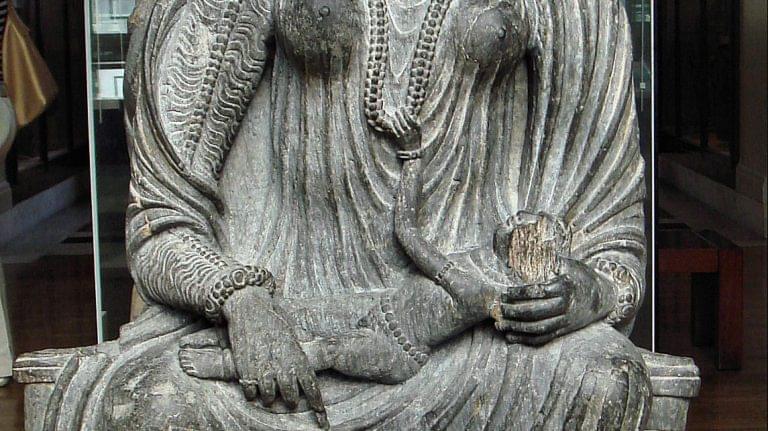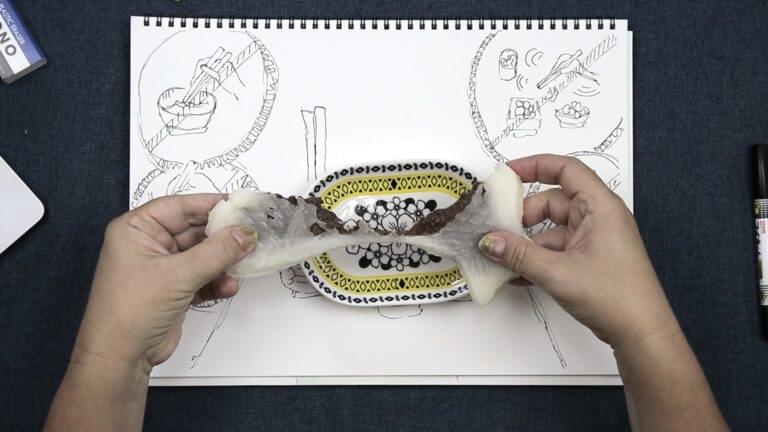Have you ever watched a sumo match? On top of a square, packed earth platform called a dōhyō stand two giant wrestlers called rikishi. They’re wearing nothing but a mawashi, a 30-foot long, 2-foot wide, thick silk loincloth, and they have their hair waxed with fragrant binzuke into a beautiful chonmage. Before they enter the ring proper, they perform some purification rituals, like clapping their hands and stomping their feet, and scooping up a handful of salt and tossing it into the center of the ring. This is called shiomaki.
Back when I used to watch religiously, there was a rikishi named Mito Izumi, who was famous for throwing a huge amount of salt very dramatically. The crowd loved it. My mother-in-law called him a show-off, but he was nicknamed the Salt Shaker. Salt.
Hey, hey, I’m Thersa Matsuura, and you’re listening to Uncanny Japan, the podcast about mysterious yōkai, fascinating folklore, endearing superstitions, and all the more obscure parts of Japanese culture. Did you know there is a Shinto kami, god or spirit, of salt? Yeah, me neither.
Then I started posting daily kami cards drawn from my Japanese god oracle deck over on Blue Sky. One day I chose Shio-tsuchi-oji-no-kami, or Shio-tsuchi-oji-no-kami chose me, and down the rabbit hole I went. I’ve always wanted to do an episode on salt, and now here we are. So today I’ll talk about the shinto kami and other interesting salt uses and rituals.
Salt’s Historical Challenges in Japan
Salt. It’s called shio in Japanese. It’s been a cornerstone of human civilization forever. It preserves food, enhances flavor, and was and is still used in rituals for purification and protection. Salt routes were extremely important to trade and political power all over the world. Just the other day I climbed this mountain to visit a 1,300 year old shrine, partly dedicated to a tengu, and while walking around this narrow path, I saw a small stone marker indicating that trail used to be an ancient salt route. I didn’t take a photo because I wanted to get off the mountain before it got dark and the light was already fading pretty fast, but now I wish I had. Researching just this week, I see how that exact salt route was so important and I was standing right on it.
But salt’s never been easy in Japan. The country isn’t blessed with vast arid land suitable for sun-dried salt production, and it doesn’t have natural rock salt reserves or salt flats, so the Japanese people had to be creative in their procurement of this treasured mineral. Be creative or ask a god.
Meet the Salt God: Shiotsuchi-oji-no-kami
Let me introduce you to Shiotsuchi-oji-no-kami, literally, “salt ground honorable old man god.” He’s the deity of salt and navigation, and it’s believed that he’s the one that taught early Japanese the art of extracting salt from seawater around 2,000 years ago. This very old technique is called moshioyaki. It involves drying seaweed in the sun, scraping salt crystals off the seaweed, dissolving those back into seawater to get a very concentrated brine, then boiling that in earthenware pots until you get only salt. This ritual is still performed once a year at a small place just below Shiogama Shrine, by the way.
Shiogama Shrine is in Miyagi Prefecture, and if you want to meet Shiotsuchi-oji-no-kami, that’s where he’s enshrined. A place that just coincidentally has deep historical ties to salt production in Japan. Shiogama, by the way, means “salt cauldron.”
A little more mythology. Around 2,000 years ago, Amaterasu, the sun goddess, gave orders to two sword-wielding gods to go and establish the northern Tōhoku region in Japan. There was a third deity, though, Shiotsuchi-oji-no-kami, who shuffled off and went to make sure a certain area of Tōhoku stayed safe and peaceful, not ransacked by the other two kami. This area was and is where Shiogama Shrine stands today.
How powerful is the salt spirit? Well, during the Tōhoku earthquake, the tsunami rose all the way to the very edge of the shrine before it retreated again, doing no damage at all.
Sacred Salt: Purification in Japanese Culture
So salt holds profound significance in Japan, and not just for preserving food and making it taste better, either. It’s a sacred mineral and believed to purify spaces, objects, and people, too. You’ll find it in some unexpected places. I mentioned at the beginning the sumo wrestlers throwing salt to purify the ring before the match, a symbolic gesture to also pray for no injuries.
Another place is have you ever been to a funeral in Japan? I hope you never have to go to one, but if you do, you’ll be given a small packet of salt. This is called kiyomejio, or cleansing salt. Don’t sprinkle it on the obento you’re served, if you’re given one, that is, at the funeral home. They have a room where friends and families wait while their dear departed is cremated. Where I live, you’re served a really nice lunch while you wait.
Anyway, you take the kiyomejio home with you, and don’t forget before you enter your house to open it and sprinkle it on your shoulders, or all over your head. My area is just the shoulders. This will prevent any hangar-on spirits from entering your house. I remember having a serious discussion with my mother-in-law. What if Great-Grandma Fumie wanted to come home with us? Why do we have to scare her away with salt? She assured me that the good relative spirits can do whatever they want. It’s the other creepy ghosts lurking in the crematorium that are looking for a ride into someone’s house.
Morishio: The Mysterious Salt Pyramids
Another use of salt you might have seen is called morishio. These are pretty cool. Morishio means “piled salt,” and that’s exactly what they are. Tiny bowls or saucers with a small conical mound of salt on them. If you’re paying attention, you’ll see them on both sides of entrances to homes, businesses, restaurants. They cleanse the area of negative energies, they ward off bad spirits, and they also attract prosperity and good spirits and customers, too.
Back to my mother-in-law. For a period when my in-laws were having some health issues, she began placing morishio all around the house. She was told by the person who advised her to do so, I’m guessing a Shinto priest, but I’m not sure, to change the salt at the end of the day and to be sure never, ever to touch it, because it was impure. She should use throw-away chopsticks to knock the old salt into the trash. So I always imagined the salt sucking up all the bad energy and freaky ghosts in the house. She even said that some of the salt was much firmer in certain areas of the house, and that must mean there were more mischievous spirits there. I agreed, and I didn’t say anything about how a spot near an open window or the bath or the kitchen might affect the state of the salt.
So here, let me tell you a couple of fun words and phrases about salt. “Shoppai” means salty. “Shoppai kao,” or salty face, is the face you make when you bite into something really salty, like a grimace or a disagreeable face, furrowed brow, tongue sticking out. So it’s used not just when licking an over-salted rice ball, but if you hear some unfavorable news, you can make a “shoppai kao.”
The Samurai Honor Code: Sending Your Enemies Salt
Now, let me end by telling you a story about my favorite phrase using salt. The saying is, “Teki ni shio wo okuru,” sending your enemies salt. Back during the warring states period, in the 15th and 16th centuries, there was something called the Shio no Michi, or salt road. I mentioned it earlier. It was a very treacherous route that ran across the middle of Japan, up and down mountains, and was used to deliver salt to the middle provinces. It’s historically well known and ran from Itoigawa, on the sea of Japan, to Shiojiri, salt butt, on the Pacific Ocean.
During the Sengoku, or warring states period, there were battles everywhere. There was also a powerful warlord named Takeda Shingen, who ruled in a landlocked area along the salt route. Only his enemy to the south cut him off from getting any salt. Takeda’s other arch-enemy, on the other side, up north, on the sea of Japan, was Uesugi Kenshin. Uesugi heard about this and offered to provide Takeda with salt. He said that battles should be fought with weapons, not by denying necessities like rice or salt to the people. That, he said, was a truly cowardly way to fight.
And so came the proverb, “Teki ni shio wo okuru,” give your enemies salt, meaning not to take advantage of enemies’ weaknesses, or don’t fight dirty, but battle honorably.
Okay, that’s enough for today. I probably won’t get to talk to you before New Year’s, so everyone please have a warm and wonderful Oshōgatsu New Year season, and may this episode bring purification and godliness into your 2025. I’ve got a niggling feeling that we’re going to need it.
Oh, and also remember the Book of Japanese Folklore makes an excellent Christmas gift, or hey, New Year’s gift. You can also support the show on Patreon, where I talk a lot more about exciting news and behind-the-scenes local shrines and temples, recipes, stories, all kinds of stuff like that. Everyone have a safe, warm, and delightful Christmas. Thank you for listening, and I’ll talk to you in the year of the snake in a couple weeks. Bye-bye.







Thanks for helping me with my research today, Thersa! This is all very cool (and applicable to my WIP).
You’re welcome, Sara ♪(๑ᴖ◡ᴖ๑)♪ I’m so excited to hear about your new book. I’m shuffling two big projects off the desk soon and *really* looking forward to getting back to my WIP which just keeps getting sidelined over and over, darnit.